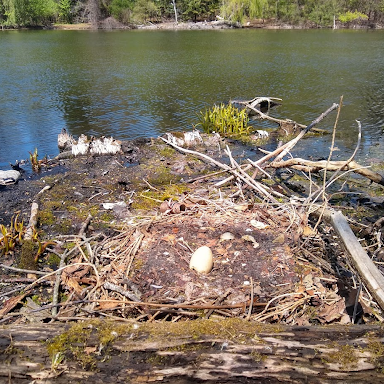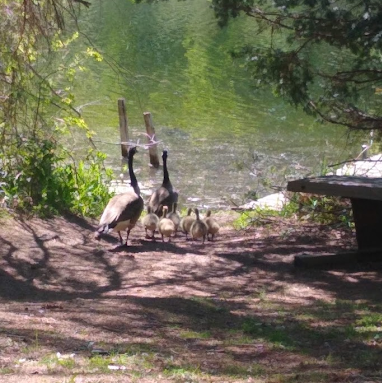Creature Feature: O Canada…Goose
Birds may respond to the changing of seasons in different ways. At least 350 bird species in North America perform long distance migrations, while others may tolerate cold winters in its entirety. One of the first signs of spring is when migratory birds begin returning to their summer range, bringing with them their songs and melodies. The American robin is a common bird species often used as an example of this type of activity. For this month’s Creature Feature we shall be examining that big honker we all know and love: the Canada goose.
Some of you might be thinking “Seriously? Of all the unique migratory birds one could choose from, you pick that?”. Hear me out, because these geese may have a secret or two that not many people may know about. The Canada goose (Nika, in the Ojibwe language) is part of an order of birds called Anseriformes. This order is also known by its more common name, waterfowl. Here at the Johnson Nature Center, we have a mated pair of Canada geese that have been returning to this site to nest and raise their goslings. Last year, the geese built their nest beside a portion of our boardwalk. In response, the nature center team closed off that portion of the trail largely for two reasons. One reason is that Canada geese are one of many species protected under the Migratory Bird Treaty Act. Beginning in 1918, the act serves to protect both migratory bird species and their products (eggs and nest, for example) from instances of theft, poaching, harassment, etc.
Canada goose nest after hatching. All that remains is an empty goose shell
The second reason is that Canada geese are not afraid to confront humans if they feel threatened. While the female builds the nest and incubates the eggs, the male will defend what it views as its territory around the nest. Incubation takes a little under one month for the goslings to hatch. Shortly after hatching, the family will leave the nest and spend the next several weeks roaming their aquatic environment. In the case of our geese at the nature center, the male perceives the entire pond as its territory, and is not afraid to ward off any animal it views as a potential threat. This can include hissing, flapping, and nipping. Inside of a goose's mouth, you may notice jagged points that look like teeth around both the beak and tongue. These “teeth” are not the same kind as you or I, but a kind of cartilage (the flexible material in our noses and ears) called tomium. The tomium of geese is primarily used for grazing and shredding vegetation, but can also be used as a way to defend itself.
You are very likely to find Canada geese where there is a combination of water and open spaces such as a lawn or field. Even though they are herbivorous, they will adjust their diet according to the season. Specifically, they would focus on grass and sedges for one half of the year, and berries and seeds during the second half. Due to its large population and adaptability to human environments, some view this species in a negative light due to the waste it leaves behind and their potential to impede on day to day activities.
One final fact: If you travel west of Michigan you may come across a goose that looks extremely similar to the Canada goose, but is actually a different species! This bird is called the cackling goose, and one of the only ways to tell the two geese apart is based on its size (the cackling goose is significantly smaller than the Canada goose). Imagine trying to spot a cackling goose within a large flock of Canada geese, I would consider it nature’s version of Where’s Waldo?
You may spot our Canada goose pair this spring when you visit the Johnson Nature Center. Remember, Canada geese can be fierce defenders, be mindful of their space as their brood is incubating.
Click here to learn more about Canada geese and their life history.
Submitted by Zach Mork, Naturalist, April 2022


